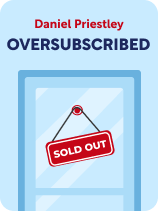

This article is an excerpt from the Shortform book guide to "Oversubscribed" by Daniel Priestley. Shortform has the world's best summaries and analyses of books you should be reading.
Like this article? Sign up for a free trial here.
What does “demand breeds demand” mean? What’s more effective than mass marketing? When should you bring your product to market?
Oversubscribed by Daniel Priestley starts with an unusual premise: Get more people interested in your product or service than you could possibly serve, and don’t start selling it until that happens. He discusses why and how to do this and explains how to run a successful marketing campaign.
Continue reading for an overview of this practical book that can get you on the path to solid sales.
Overview of Oversubscribed by Daniel Priestley
Oversubscribed by Daniel Priestley gives you a method that practically guarantees profitability for your product. Priestley says you can minimize the risk and maximize the profit of running a business by leveraging supply and demand—ensuring that there’s always more demand than supply. The rest of the book teaches you how to attract that level of demand.
Daniel Priestley is a serial entrepreneur who’s founded several multi-million dollar businesses around the world, as well as co-founding Dent Global, which offers entrepreneurial training programs. He’s also the author of four bestselling books for entrepreneurs; Oversubscribed is the most popular of these. Enterprise Nation named Priestley one of the UK’s top ten business advisors in 2018.
First, we’ll discuss why and how you should build demand for your products before starting to sell them. Then, we’ll explore Priestley’s instructions for how to run a successful marketing campaign.
Create More Demand Than You Can Meet
Let’s examine the foundational lesson of Oversubscribed: Attract more customers than you can serve to maximize your profits.
The Core Message: Exploit the Law of Supply and Demand
Priestley explains that the law of supply and demand influences the price of a product—the harder something is to get, the more that thing costs. So, if there’s more demand than supply for a product, you can charge high prices for it, thereby making a significant profit.
Furthermore, demand breeds demand: people are more likely to want something that’s very popular and hard to get. Therefore, make sure to continue advertising even after customer demand exceeds your supply.
Build Demand Through Word-of-Mouth
Priestley warns that mass marketing strategies like commercials and printed advertisements aren’t as effective as they used to be. Rather than mass marketing, Priestley says that word-of-mouth is the best form of advertisement—in short, people will buy what their friends are buying. In fact, word-of-mouth marketing is more effective than ever because social media allows your customers to advertise your company to their connections quickly and easily.
Method 1: Differentiate Yourself
The most effective way to stand out is to offer something truly unique. If you can’t create a unique product, then you’ll need to give yourself an edge over your competitors. One strategy is to undercut their prices; if you can provide similar products at a lower price than your rivals, people will tend to favor your company. A third way of attracting attention is to offer a product that’s more convenient than the current options.
Method 2: Advertise Your Company, Not Just Your Products
Almost any popular product—no matter how innovative—will soon face competition from imitators and cheap knockoffs. Therefore, you need a customer base that’s loyal to your company, not just to your products. Priestly says that you can create a market niche and build brand loyalty by carefully designing your company’s image.
- Advertise your company values.
- Focus on good customer service.
Drive Interest With Campaigns
Priestley says that running a successful business—one with more demand than supply—requires you to be a campaign manager rather than a salesperson. In other words, he suggests that you connect with large numbers of people at once through special events and mailing lists rather than trying to draw in one customer at a time.
We’ve organized Priestley’s method into five steps.
Step 1: Determine Your Supply
Priestley says that you need to figure out exactly how much supply you have—in other words, how many customers you can serve and how often. Only once you know your business’s capacity can you start making plans to exceed it.
Step 2: Prime the Market
You need to know who you’re selling to. What kind of people would you enjoy working with? Would those people want what you’re selling? Can they pay your prices?
Let those people know what you’re selling and get them interested in buying from you. Priestley suggests sending regular newsletters with information about your products and services, upcoming sales and special events, and what you’re working on next. Aside from a general newsletter, you might offer customers subscriptions for updates about specific products.
Step 3: Reach Critical Mass
Priestley sets three different goals and says that, if you’re meeting at least one of them, you’re in good shape to bring your product to market:
- If people express strong interest, sell when there’s five times as much engagement as there is product.
- If people express moderate interest, sell when there’s 10 times as much engagement as there is product.
- If people express mild interest, sell when there’s 100 times as much engagement as there is product.
Step 4: Make the Sales
Once you’ve got enough engagement to be confident that your product will succeed, it’s time to actually make the sales.
Priestley says that this is where a lot of new companies stumble. People often feel uncomfortable asking for customers’ personal information and money, so they waste time with small talk and fail to actually close the deal. Just remember: If you’re having a sales conversation with someone, it’s because that person has already expressed interest in buying your product. In other words, you and the customer both know that the purpose of the conversation is to collect information and money, so there’s no reason to feel uncomfortable about it.
Step 5: Keep People Talking
When fulfilling orders, Priestley suggests giving your customers more than you promised. Note that exceeding expectations doesn’t mean you have to work harder or strain your resources; you can accomplish the same thing by setting customer expectations a little lower at the start.
Finally, when you start your next advertising campaign, make sure to broadcast how successful your business already is. Remember: Demand breeds demand, and people want what’s hard to get.

———End of Preview———
Like what you just read? Read the rest of the world's best book summary and analysis of Daniel Priestley's "Oversubscribed" at Shortform.
Here's what you'll find in our full Oversubscribed summary:
- Why you should build demand for your product before you even release it
- How to run a successful marketing campaign
- Why word-of-mouth advertising is more effective than mass marketing






